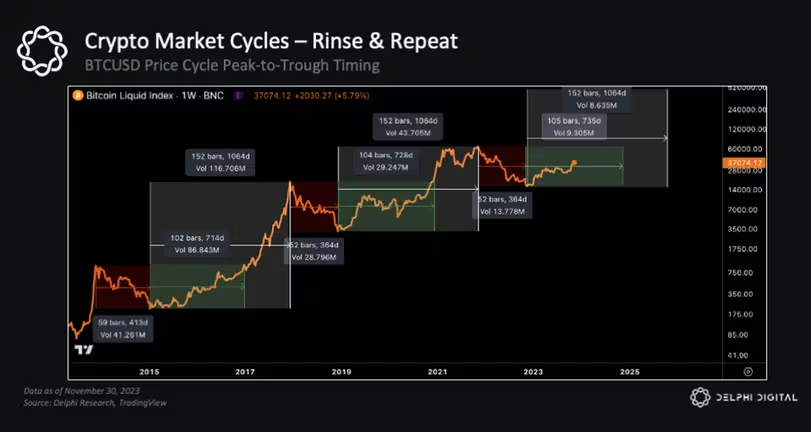The world of crypto may seem unfamiliar to many, often appearing unpredictable in its movements. However, much like traditional financial markets, cryptocurrencies follow distinct crypto market cycles that are surprisingly consistent, including the timing of their peaks, bottoms, recoveries, and eventual rallies to new highs.
Although Bitcoin is only celebrating its 15th anniversary this year, we’ve already seen three major market cycles: 2011-2013, 2015-2017, and 2019-2021.
Understanding the crypto market cycle and learning how to navigate them is important for long-term success.
Hedging is one of the most powerful strategies that can help investors protect themselves during market downturns. Whether through traditional methods or new tools like those offered by platforms such as ChaiDEX, hedging allows you to guard your assets while still benefiting from the market’s upside.
What Are Market Cycles in Cryptocurrency?

A market cycle is a recurring pattern observed in all financial markets and the cryptocurrency market is no exception. These cycles represent the collective behavior of market participants, which tends to follow phases of growth, peak, decline, and recovery.
What sets the cryptocurrency market apart is the extreme volatility and 24/7 trading, which amplifies both the upward and downward movements in prices.
While traditional markets have fixed trading hours and are influenced by earnings reports, economic data, or corporate performance, crypto markets are more reactive to global liquidity, investor sentiment, regulatory changes, and technological developments.
Understanding these cycles is essential for investors because it provides a roadmap to anticipate market movements, make more informed decisions, and hedge against downturns.
The Four Phases of a Crypto Market Cycles

A typical crypto market cycles consists of four main phases, viz; Accumulation, Run-Up (Bull Market), Distribution, and Run-Down (Bear Market). These phases have played out time and again since Bitcoin’s inception, but the timeline is compressed in comparison to traditional markets.
Let’s break down each phase.
Accumulation Phase
This phase is of the crypto market cycle after a major decline, often following a crash or “bear market.” Prices reach a bottom and stabilize as weak hands (those who panic-sell) leave the market.
Savvy investors, often referred to as “smart money,” start buying, seeing this as an opportunity to accumulate assets at lower prices.
At this point, sentiment is typically low, and mainstream attention is minimal. Investors who remain are cautious, but those who are confident in the market’s long-term potential begin to accumulate assets, anticipating a future bull market.
For example, after Bitcoin’s dramatic fall from $64,000 in 2021 to around $30,000, the market entered a period of accumulation in early 2022. During this phase, smart money began buying Bitcoin again, expecting a new cycle to emerge.
Run-Up (Bull Market)
This phase, often called the markup phase or bull market, is characterized by rising prices. During this crypto market cycle phase, confidence begins to grow and more investors enter the market, driving demand. Prices rise steadily at first but may start to increase rapidly as retail investors rush in, fearing they might miss out on profits (often called FOMO or “Fear of Missing Out”).
Optimism and excitement dominate this phase. Media coverage increases, and everyone seems to be talking about the booming market. This phase typically attracts new participants who want to ride the wave of rising prices.
In 2021, Bitcoin and the broader crypto market experienced a strong bull market, with Bitcoin reaching all-time highs above $60,000. Altcoins like Ethereum and Solana followed closely and gained significant value during the bull market due to liquidity being flooded into the market from both retail and institutional investors.
Distribution Phase
After the massive price surge in the bull market, the distribution phase sets in. Prices hit a peak as early investors begin to sell off their holdings and take profits.
While some investors remain optimistic, sentiment starts to turn more cautious, and market activity becomes more erratic. The price may fluctuate within a range with no clear upward trend.
This phase is often characterized by a tug-of-war between greed and fear. Some investors continue to believe the bull market will go higher, while others fear that a downturn is imminent. This is the time when institutional investors and large holders, also known as “whales,” begin to exit the market, quietly taking their profits.
A perfect example for this is — in late 2021, as Bitcoin reached its peak at $69,000, savvy investors started taking profits. This is a classic distribution phase where the bulls and bears are in tension. Although prices remained high for a while, sentiment started to shift as concerns about market sustainability emerged.
Run-Down (Bear Market)
The bear market phase follows the distribution phase in the crypto market cycle. As early investors continue to sell off their holdings, supply exceeds demand, and prices begin to fall.
The decline can accelerate quickly as panic sets in and more investors sell their positions to cut losses. In crypto markets, these downturns can be sharp and severe, with prices often dropping by 80% or more from their highs.
Fear dominates this phase. Panic selling, exacerbated by negative news and events, leads to further downward pressure on prices. Many retail investors exit the market during this phase, often at significant losses.
After Bitcoin reached its peak in November 2021, the market quickly entered a bear market. By mid-2022, Bitcoin had fallen below $20,000. Panic-selling ensued as fear over macroeconomic issues, such as rising interest rates and inflation compounded the market’s struggles.
Why Are Crypto Market Cycles So Extreme?
There are a few reasons why crypto market cycles are more extreme than traditional markets—
- Volatility: Cryptocurrencies are notoriously volatile. While a 2-3% daily move in stock markets is significant, it’s not uncommon for crypto assets to move 10-20% or more in a single day.
- 24/7 Trading: Unlike traditional markets, which close on weekends and holidays, the cryptocurrency market operates 24/7. This continuous trading means that cycles can play out more quickly, and events (both positive and negative) have immediate effects.
- Speculative Nature: Much of the value in crypto is speculative. Investors often buy into the market not based on fundamentals (which should be the case) but because of the potential for huge returns. This speculative buying can drive prices up rapidly, but it can also lead to panic selling during downturns.
- Liquidity Factors: Cryptocurrencies are highly correlated with global liquidity trends. During periods of high liquidity, such as when central banks are engaging in expansionary monetary policies, crypto markets tend to thrive. Conversely, when liquidity tightens, as seen in 2022 with rising interest rates and inflation concerns, crypto markets suffer dramatically.
In crypto, sentiment drives much of the price action. The market tends to be driven by extreme emotions—greed during bull markets and fear during bear markets.
In 2021, after China announced a crackdown on Bitcoin mining, the market’s reaction was swift and brutal. Bitcoin lost more than 50% of its value in a matter of weeks, as fear spread through the market.
This is where hedging comes into play. By using hedging strategies, investors can protect themselves from the worst effects of sentiment-driven swings.
The Importance of Hedging During Crypto Market Cycles
Hedging strategies allow investors to protect their portfolios during both the run-up and run-down phases. For example, during a bull market, you might use liquid staking on ChaiDEX to keep your assets productive while still maintaining liquidity in case of a sudden market turn.
Similarly, in the bear market, you can use perpetual contracts to hedge against falling prices, as these allow you to profit from the price drops.
Nitesh Mishra, Co-Founder at ChaiDEX, reflects on market trends,
“In the last decade, BTC saw annual returns of 49-61% due to retail speculation. This decade, returns are expected to range from 10-15%, primarily driven by institutional efforts. Hedging your virtual asset class can offer better returns than mere speculative actions.”
Nitesh Mishra, Co-Founder at ChaiDEX
By understanding and anticipating these crypto market cycles, and by using the right hedging tools, investors can safeguard their assets and even profit from market downturns.
What is Hedging and Why is It Important?
Hedging is a risk management strategy. This is a strategy where traders simultaneously open two opposing positions in a digital asset.
It’s like buying insurance for your investments. The idea is that by taking steps to protect your portfolio, you reduce the impact of market swings.
Traditional hedging tools include options, futures, and short selling. In the crypto world, we also have new tools like liquid staking, perpetual contracts, and restaking protocols that add even more flexibility.
Hedging is especially important in crypto where prices can swing 20-30% in a single day. Without protection, these moves can wipe out gains or cause significant losses.
ChaiDEX, a decentralized, multi-chain platform uses a combination of old and new hedging strategies. These include traditional tools like perpetual contracts and blockchain-specific tools like liquid staking and restaking. This allows investors to “protect their principal while generating more returns” by earning rewards even during market downturns.
How to Use Hedging in Each Market Cycle
Hedging is not just for experts—it’s a critical tool that every crypto investor can use to navigate the ups and downs of market cycles. By using the right hedging strategies at each phase of the cycle, you can protect your portfolio, generate returns, and avoid emotional decision-making.
But how exactly should you approach each phase? Let’s break it down.
Accumulation Phase
This is the perfect time to focus on staking strategies—particularly Native Staking (Proof-of-Stake Protocol Staking), Custodial Staking, or liquid staking. These methods allow you to earn rewards while holding assets, ensuring your portfolio grows during the quiet market period.
Staking allows you to lock your assets in a network to earn rewards (usually in the form of more tokens), while liquid staking platforms like ChaiDEX lets you stay flexible by giving you derivative tokens that you can use elsewhere in DeFi.
Run-Up Phase
As prices rise, continue using liquid staking to keep earning rewards but maintain liquidity to sell or reinvest if necessary. Liquid staking also gives you the flexibility to capitalize on other opportunities, like lending your staked assets in DeFi to earn interest, without missing out on the bull market’s price appreciation.
At this point, you can also explore Automated Market Makers (AMMs) and liquidity provision to capitalize on high trading activity.
Distribution Phase
The distribution phase occurs after the bull market has reached its peak. During this phase, consider using perpetual contracts to hedge against a potential downturn. Short positions can help you profit from falling prices.
Run-Down Phase
Focus on staking and restaking strategies. In crypto, your assets should never sit idle—even in a bear market. This allows you to earn consistent rewards while the market declines, helping to offset losses.
The Bottom Line
Crypto market cycles are inevitable. But that doesn’t mean you have to ride the waves blindly. Understanding these cycles and using hedging strategies can help protect your investments and grow your wealth even in volatile markets.
Each phase of the crypto market cycles requires a different hedging approach. By using strategies like Native Staking, liquid staking, AMMs and liquidity provision, perpetual contracts, and restaking, you can protect your assets, generate returns, and avoid panic during downturns.
With the right hedging tools—such as those offered by platforms like ChaiDEX—you can steer through these cycles with confidence and protect your investments from the extremes of the crypto market.



















